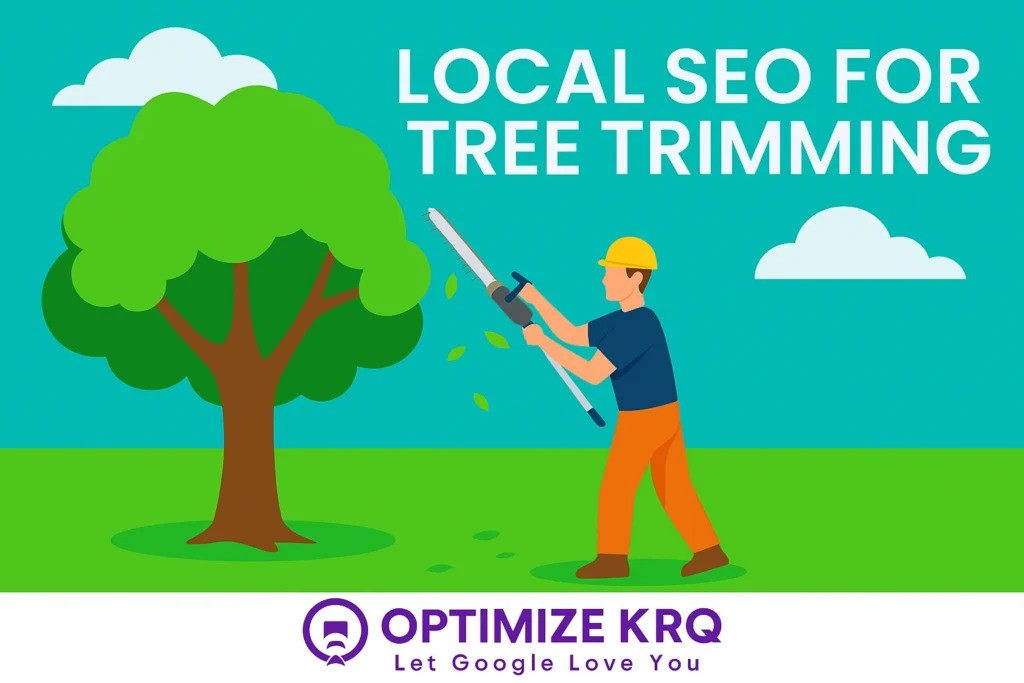If you run a tree trimming business, chances are most of your customers are local homeowners, property managers, or businesses in your area. That’s why local SEO (Search Engine Optimization) is one of the most powerful marketing strategies to bring in new clients. By optimizing your online presence, you can appear at the top of Google search results when people look for “tree trimming near me” or “tree service [your city].”

In this guide, we’ll cover the best local SEO tips for tree trimming companies.
1. Optimize Your Google Business Profile (GBP)
Your Google Business Profile is your most important online asset for local SEO.
- Claim and verify your listing at Google Business Profile Manager.
- Add your business name, address, and phone number (NAP) consistently.
- Include business hours, service areas, and website link.
- Upload high-quality photos of your team, equipment, and completed jobs.
- Use keywords like tree trimming, pruning, stump removal, tree care in your business description.
- Encourage happy customers to leave Google reviews regularly.
2. Target Local Keywords
Use location-based keywords throughout your website and content. For example:
- “Tree trimming in [City, State]”
- “Affordable tree service near [Neighborhood]”
- “Emergency tree removal [City]”
You can also create dedicated service area pages targeting different towns or regions you serve.
What Our Clients Say
Trusted by contractors and local businesses for proven Local SEO Services.
John M. – General Contractor
“These guys transformed my Google Maps ranking. More calls, more local leads, and better visibility!”
Sarah L. – Roofing Business
“Within 3 months, my business went from page 3 to the top 3 listings. Highly recommend their Local SEO service!”
David K. – Plumbing Services
“Affordable and effective SEO. My local service calls doubled in less than 90 days.”
3. Build Local Citations
Local citations are mentions of your business name, address, and phone number across online directories. Ensure your info is accurate and consistent everywhere.
- Submit to directories like Yelp, Angi, Thumbtack, and Houzz.
- List your business in local chambers of commerce and community websites.
- Check for and fix duplicate or incorrect listings.
4. Optimize Your Website for Local SEO
- Add your city and state to page titles, meta descriptions, and headers.
- Create a dedicated “Service Areas” page.
- Include a map with your service radius.
- Add a click-to-call button for mobile users.
- Publish blogs or articles about seasonal tree care tips, common problems in your region, or safety advice.
Read More:
Local SEO for Lawn Care
Local SEO for Fence Repair
Local SEO for Fence Installation
Local SEO for Patio Builders
5. Get Customer Reviews & Testimonials
Reviews are crucial for trust and SEO ranking.
- Ask satisfied clients to leave reviews on Google, Yelp, and Facebook.
- Respond to all reviews (positive or negative) in a professional way.
- Showcase testimonials on your website.
6. Use Local Link Building
Backlinks from local sites strengthen your authority. Try:
- Partnering with landscaping companies or nurseries for cross-promotion.
- Sponsoring local events or charities.
- Getting featured in local news or blogs about community services.
7. Leverage Social Media & Content
Stay active on platforms like Facebook, Instagram, and Nextdoor.
- Post before-and-after tree trimming photos.
- Share short tips on tree health, storm preparation, or pruning schedules.
- Run local promotions or discounts.
8. Track & Adjust Your SEO Strategy
Use tools like Google Analytics and Google Search Console to monitor:
- Website traffic
- Keyword rankings
- Clicks from Google Maps
- Calls and form submissions
Adjust your strategy based on results to keep improving.
Final Thoughts
Local SEO for tree trimming isn’t a one-time job—it’s an ongoing effort. By optimizing your Google Business Profile, using local keywords, building citations, collecting reviews, and posting helpful content, you can outrank competitors and consistently attract new local clients.
Local SEO is the practice of optimizing your website and online presence so that people in your service area find you when they search for tree trimming services (e.g. “tree trimming near me” or “tree trimming in [your city]”). For tree trimming businesses, local SEO is essential because most customers look for providers close by, and appearing in local search (especially the map/local pack) drives calls and leads.
You’ll want a mix of:
Service + location (e.g. “tree trimming in [city/neighborhood]”)
“Near me” queries (e.g. “tree trimming near me”)
Cost or price‐related searches (“cost to trim a tree”)
Emergency or seasonal phrases (“storm tree trimming”, “emergency tree trimming service”)
Keyword tools show that terms like “tree trimming near me”, “tree trimming”, “tree service near me” are high volume.
Some key steps:
Claim and verify your profile.
Ensure name, address, phone number are accurate and consistent (NAP).
Use the correct primary category (probably “Tree Service” or “Arborist”) and add relevant secondary categories.
Upload high quality photos (before/after work, crews, equipment) to show credibility.
Encourage reviews and respond to them. Recent, high-quality reviews help both ranking and trust.
Yes. If you serve multiple cities, neighborhoods, or distinct regions, creating pages tailored to each area (with unique content) helps your business show up in local searches for those places. Include localized keywords, local references, testimonials or photos from those areas. Make sure you avoid duplicate content across pages.
Very important. Citations (mentions of your business name, address, phone) in online directories and listing sites help local SEO because they build legitimacy and consistency of your information across the web. Make sure the data is accurate everywhere. Quality over quantity: good directories, relevant ones, matter more.
Reviews are a strong local ranking factor. Quantity, quality, recency, and diversity (i.e. on different platforms) help. Good reviews increase customer trust and often lead to better click-throughs from search results or map listings. Also, having frequent, positive reviews signals to Google that your business is active and valued.
Key technical optimizations include:
Fast page load speed, especially on mobile.
Mobile responsiveness. Many users search from phone.
Clear site structure: separate service pages (tree trimming, removal, maintenance, etc.), location pages as needed.
Using schema / structured data (LocalBusiness schema, service schema) to let search engines understand what you do and where.
It depends on factors like competition in your service area, how well your site is set up already, how frequently you generate content/reviews, and how many good local signals (citations, backlinks, etc.) you can build. Generally expect some improvements (e.g. more local visibility, map pack appearances) within a few weeks to a few months, but meaningful lead growth often takes 3-6 months of consistent work.
That depends on your business goals, size of service area, competition, and whether you outsource vs handle in-house. Key recurring costs/time investments include:
Maintaining/updating your Google Business Profile & directories
Generating content (blogs, service pages)
Review management
Technical maintenance (speed, mobile, schema)
Possibly paying for tools for keyword tracking, citation monitoring, etc.
Some frequent missteps:
Not optimizing for location (leaving out city/neighborhood names).
Duplicate content on different landing pages.
Ignoring mobile user experience.
Missing or inconsistent NAP across listings.
Not encouraging or managing reviews.
Having few or low-quality photos or no proof of past work.

Gulfam Qamar is a seasoned Local SEO expert with a proven track record of helping businesses boost their online visibility and dominate local search results. With deep expertise in Google Business Profiles, on-page optimization, and local citation strategies, Gulfam helps brands connect with nearby customers and grow sustainably. When he’s not optimizing websites, he’s sharing actionable SEO tips and insights to empower small businesses in the digital space.

